Hands on review of the Olympus EPL-1 and PT-EP01 housing.
Hands on review of the Olympus EPL-1 and PT-EP01 Housing.
Olympus officially launched its first Micro Four Thirds camera the E-P1 in June of 2009 after a clever advertising campaign linking it to the very popular PEN film cameras of the 1960s and 70s. Fast forward to February 2010 and the official announcement of the Olympus E-PL1, a simplified and less expensive addition to its Micro Four Thirds camera line. The E-PL1 is the third camera in the PEN line and at a consumer friendly MSRP of $599 with the Olympus M. Zuiko Digital ED 14-42 mm “kit” lens will appeal to compact camera shooters wanting to move up. Olympus also announced the new PT-EP01 underwater housing for the E-PL1 camera at an MSRP of $599. Olympus has a great track record for introducing appropriate cameras with underwater housing and then getting the housings to dealers soon after the launch of the new cameras. This allows the buyer time to learn the cameras functions and to be assured that a housing will be arriving soon after the camera.
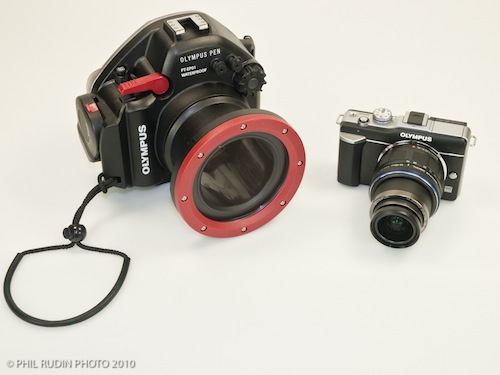
THE E-PL1 CAMERA.
Olympus developed the first Four Thirds DSLR cameras and the Micro Four Thirds cameras share the same sensor (e.g. 17.3 x 13 mm) and image quality. The E-PL1 is an electronic viewfinder/ interchangeable lens camera body sometimes called EVIL or Micro Four Thirds. This mirrorless, live-view camera has established itself as a new breed gaining creditability with both consumer compact and DSLR owners. The sensor size, interchangeable lenses and compactness of these mirrorless cameras is what set them apart from the mainstream. Consumer compact cameras on average have sensor sizes nearly five times smaller than the Micro Four Thirds sensors and fixed lenses most of which do not exceed F/8 due to the tinny size of the sensor. The Micro Four Thirds cameras have image quality on par with many of the DSLR cameras with the APS size sensor. They are much more compact because they are constructed without the large mirror box and optical viewfinder and far less expensive. Some of the main features of the E-PL1 body include a 12.3 megapixel Micro Four Thirds sensor, in-body image stabilization, “live guide” interface, built-in flash, 720p HD video with direct record button, 100 to 3200 ISO, six art filters for creative effects and a hot shoe for add-on accessories like the outstanding VF-2 electronic viewfinder, external strobes, and external microphone adapters. Because the Micro Four Thirds platform is an open standard lenses from other manufactures can be used with excellent results. Panasonic is the other leader in the Micro Four Thirds arena and has released several lenses along with Olympus which are ideal for underwater photography.
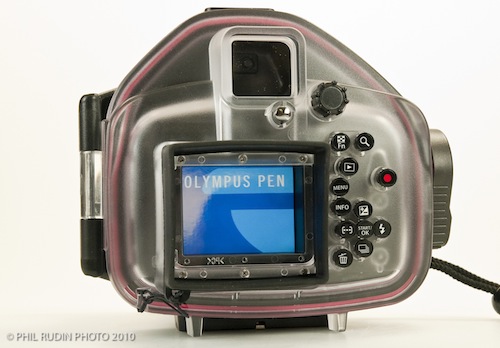
Before starting a review of any new camera I like to field test the system by capturing at least 5000 images so that I can get a feel for the controls, have a fair sampling of the lens/dome choices and can form an opinion on image quality of the images produced and the robustness of the system. While the E-PL1 has a variety of auto modes I spend most of my time shooting in manual because it gives me the best starting point for comparison to other camera systems I have also tested in manual. As a staring point I used the following basic settings on the E-PL1 for my tests, ISO-200, auto white balance, adobe raw files, Image Stabilization-1, ESP metering, single frame advance, single and continuous AF, RC mode off (this would be turned on when using the Olympus UFL- strobes), images were exposed shooting in both TTL and manual. I have found the optional VF-2 electronic viewfinder to be an outstanding option above water but it is of little use in the PT-EP01 housing because your eye is just to far back from the viewfinder while wearing a mask. The VF-2 would work very well if an accessory like the Inon 45 degree accessory viewfinder could be added to the PT-EP01 housing.
The E-PL1 produced images with excellent resolution and image detail even shooting very close with the kit lens set at 42 mm while using an add- on Inon UCL-165 close-up lens. I am sure this lens and sensor would be equally up to the challenge of using the Reefnet SubSee +5 and +10 magnifiers as well. If you are not into shooting raw files and many are not the EPL-1 has a stellar JPEG engine along with dependable metering and white balance. Auto focus performance is on par with all the Micro Four Thirds cameras, well ahead of the consumer compact cameras and a bit slow by mid-range DSLR standards. The wider the angle of view of the lenses I tested the faster the auto focus seemed. The Panasonic M. 7-14 and Olympus M. 9-18 zooms were on par with many entry-level DSLR auto focus speeds. The Olympus 14-42 mm kit lens is a bit slower than its more expensive siblings but well ahead of consumer compact camera shutter lag ranges and quite good for its cost.
THE PT-EP01 HOUSING DESIGN.
Announced along with the EPL-1 camera was the PT-EP01 Underwater Housing with a “fixed” port for use with the M.14-42 mm kit zoom and the Olympus M. Zuiko Digital ED 9 to 19 wide-angle zoom. The contents of the package include the housing with attached flat port, the instruction manual in seven languages along with warranty cards, a plastic port cover with lanyard to prevent its loss, silicone grease for the O-rings, silica gel (placed in the housing to soak up leaks), an O-ring remover, an LCD shade and a black wrist strap. Optional wrist straps are available in red, blue and orange if you wish to color co-ordinate your diving apparel. Other Olympus options for the housing include a number of flash accessories including two Olympus UFL strobes, a macro lens adapter for 67 mm threaded items like the Athena ring-flash, Inon and Reefnet SubSee close-up lenses, zoom gears for the Olympus M.14-42 mm and M. 9-18 mm lenses and shading rings for these lenses.
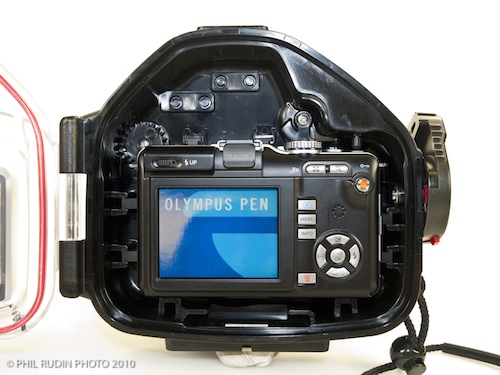
The PT-EP01 is a clam-shell style housing (e.g. front section and door held together by a hinge) made from high-grade polycarbonate. It is smaller in design but very similar to the well-regarded Olympus PT-E05 and PT-E06 housings for the E-510/520 and E-620 DSLRs. The housing has a large hinge on the left side when viewed from the rear and a rotary buckle locking device on the right which locks the housing with a firm counter-clockwise turn. The rotary buckle can be released by depressing a red locking button and turning it clockwise. This rotary style locking system has been used on many Olympus housings with great success and is very easy to use and maintain. The rear door has a single O-ring which seals the housing and prevents leaks. As always this o-ring should be removed, cleaned, re-greased and re-installed after each diving day. Like all the current Olympus housings the PT-EP01 is rated to a depth of 130 feet (40 meters), the maximum recommended depth for recreational sport divers. I have pushed that limit to 150 feet (46 meters) without issues to structural integrity or loss of push controls. The housings rear door has twelve well labeled push buttons for all twelve push button controls on the rear of the E-PL1 camera, a push button to activate the optional VF-2 electronic viewfinder and a rotating dial to control the mode wheel on the top of the camera. The top of the housing has the on/off push bottom and the shutter release lever which is presses down from the top rather than being pulled like a trigger. I found this a little awkward at first when using a try with grips. Once you hold the right side of the housing with your right hand and use the grip as a wrist support tripping the shutter becomes much more comfortable. On the left front of the housing viewed from the rear is the focus/zoom dial which is 30 mm in diameter. This dial is used to zoom lenses and could be used as a focus dial as well for fixed focal length lenses like macros. Using a tray with a grip on the left side my index finger is in perfect alignment with the zoom dial and rotating it with light weight dive gloves is a breeze. With my dry suit gloves the zoom control will be more awkward to turn. Next to the zoom dial are two optical ports for use with fiber optic strobe cords.
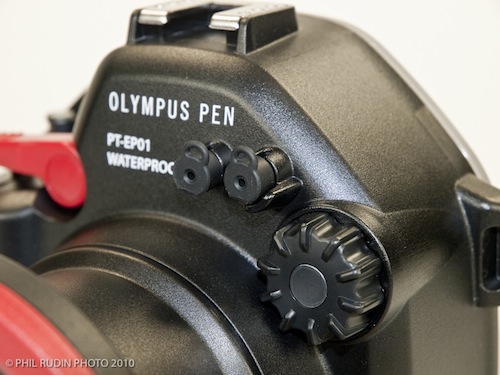
This housing has NO sync ports for wired strobe connectors and supports only strobes with fiber optic ability. For my testing I used two Inon Z-240 strobes and the new Athena ARF-01 ring- flash which uses a Sea & Sea YS-01 DS-TTL strobe head as its power source. The housing ships with two fiber optic cord holders inserted into the optical ports. These rubber holders can be used with the fiber cords that have a bare end or be removed so that the Sea & Sea type cords can be used. Note that the two rubber plugs need to be cut on the end so that the fiber optic cord can be pushed through the center of the plugs. The external strobes are triggered by the cameras pop-up flash using the exposed fiber optic cords as the trigger. Missing from the PT-EP01 housing is a way to pop-up the cameras on board flash once the housing is closed, this was not a problem with past Olympus DSLR camera/housing combinations as it could be done from the menu. The E-PL1 however has no way to deploy the flash once the housing is closed and I am sure I will curse the day I get to ninety feet and find I have forgotten to deployed the pop-up flash and have no way to fire my external strobes. The bottom of the housing has three standard mounting points for grip/tray attachment and other threaded accessories. The top of the housing has a metal cold shoe for mounting modeling lights, assorted video lights, strobe arms and an assortment of other accessories. When the PT-EP01 housing was introduced by Olympus it was advertised as a “fixed” port housing a non-removable flat port for use with the Olympus M. 14-42 mm and M. 9-18 mm zoom lenses. While these two lenses cover a wide range of possibilities and would appeal to any new comers to underwater photography, the Olympus flat port will limit the wide end of the M. 9-18 mm zoom and give less than stellar results. This is an excellent entry-level system at a very appealing cost. For under $1200.00 MSRP you get a high quality camera, a very useful kit lens and a complete underwater housing, less the $45.00 zoom gear for the kit lens and the $45.00 shading ring. By the time this article is published I am sure the number will be somewhat south of the original MSRP price.
LENSES AND PORTS:
When you open the PT-EP01 housing you will see a small phillips head screw below the shutter release device. Remove the phillips screw and a small metal port retaining clip can also be removed. Turn the dome port clockwise and it can in fact be removed from the housing just like any other bayonet mounted dome port. Once the port is removed you will see that it has two o-rings to seal it in place and a very robust mounting system. As with past Olympus DSLR housings an after market of accessory products is rapidly evolving. The most note worthy is the ZEN UNDERWATER PEN DOME PORT with a respectable MSRP of $499.00. This extremely well designed bayonet mount port incorporates the twin o-ring seals and is constructed from high-grade aluminum with a 100 mm dual coated optical glass dome. When mounted on the PT-EP01 housing it makes a very small and light package no bigger than the original Olympus flat port. The port works very well with both the wide-angle Olympus M. 9-18 mm and the M. 14-42 mm zooms. At 9 mm images are sharp into the corners at F/5.6 and above with no loss of color fidelity while retaining the lenses full 100 degree angle of view which is noticeably reduced when using the stock flat port. This port is a must have accessory if your major interest is wide-angle.
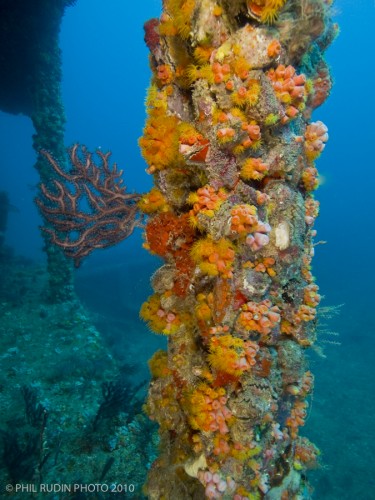
For those who already own the Olympus or Athena 170 mm dome port for the Olympus DSLR housings Athena has just released the AD/EP01 port adapter which allows all the Olympus DSLR style threaded optical glass ports to be mounted to the PT-EP01 housing. The port adapter has the same bayonet mount and twin 0-ring sealing system as the other ports and threads to mount the Olympus DSLR style ports. At present this port adapter and Olympus/Athena 170 mm port combination can be used with the Olympus M. Zuiko Digital ED 9-18 mm zoom and the Panasonic Lumix G vario 7-14 mm zoom. I have not yet tested the Panasonic Lumix 8 mm fisheye with this port system. The Athena OPF-TMP35-PTE port for the Olympus DSLR 35 mm macro lens can also mounted to the port adapter for use with the Olympus M.Zuiko Digital ED 14-42 mm zoom and the Leica DG macro-Elmarit 45 mm macro lens. The 45 mm macro lens has internal focus and the front lens element sits well inside this port reducing the distance between the front of the port and the subject by about two inches. This may not seem like much until you try to use the lens at lifesize (1:1) and find your subject pressed against the port glass or quite near it. The same Olympus gears used for the Olympus M.14-42 mm and M. 9-18 mm zooms work with the Athena port adapter. I used adhesive backed velcro on the zooming ring of the Panasonic 7-14 mm to make it bigger so the Olympus zoom gear for the M. 14-42 mm would fit the 7-14 lens. With the Panasonic 7-14 zoom set at 7 mm you get a very wide, 114 degree rectilinear angle of view. While I love the effect of some fisheye lenses I favor wide rectilinear lenses like the Olympus 7-14 F/4 DSLR lens over fisheyes for most wide-angle work.
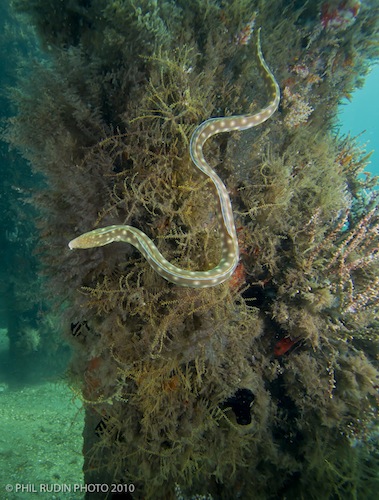
Additional dome ports are planned for release by Athena for use with their PT-EP01 port adapter and I am sure ZEN will be having a look at the coming 8 mm fisheyes from Olympus and Panasonic along with the Olympus M.Zuiko Digital 50 mm macro and M.12 mm lenses planned for release in early 2011. I did not use any of the Zuiko DSLR lenses for the Four Thirds cameras with the Micro Four Thirds lens adapter because matching ports to these lenses would be a nightmare.
This article mainly focus on still photography but I did do some video clips with the M.14-42, M. 9-18 and Pany 7-14 zooms. With the kit lens you can hear a little noise in the sound track when the lens re-focuses on a moving subject with the more expensive zooms no focus noise was detected. I shot A/V light in 8 to 12 feet (2.5 to 3.5 meters) of salt water. I am not a capable videographer so I will leave further comments on the E-PL1s video prowess to other more knowledgeable journalists.
MY THOUGHTS ON USING THE E-PL1 SYSTEM:
Do not assume that the KIT lens canʼt take quality photos. This lens has a decent range for shooting anything from divers to close-ups. Add a +5 to +10 diopter and you can approach life-size (1:1) macro images. With the Olympus port and kit lens the housing is buoyant by a few ounces in salt water. This is not a bad thing at all, I found that by the time I added a tray/ grips and some lighting it was one of the most well-balanced systems I had ever used. With its light weight and small size I was able to use the system for hours underwater, mostly holding it with one hand and not end up with a sore wrist at the end of a days diving. The ZEN and Athena ports with their respective lenses did not offset the balance by any noticeable difference. We recently dived the M/V Castor off of Boynton Beach Florida to photograph the Goliath Groupers which are beginning to congregate there in large numbers for the September spawning. This aggregation of over fifty large fish is always a highlight of the Palm Beach area dive year. I made my dive in a ripping four knot current holding the decent line in my left hand and the PT-EPL1 housing in my right hand while using the M.9-18 zoom ZEN U/W PEN dome and twin Inon Z-240 strobes. The compact and light weight package gave me an edge over other shooters who were struggling with their bulkier systems and finding it hard to remain steady while trying to shoot. The dive became much more enjoyable for me knowing I was in complete control of my camera system at all times. Using TTL with the fiber optic strobes works very well and I did not have any problems with stray light bouncing off the port using the M.14-42 zoom without the shading ring.
An external focusing light can be used to help speed auto focus when diving in low light areas, I shot 99% of my images without a light but it sure canʼt hurt to have one. I would liked to see a higher shutter sync of at least 1/250th of a second and not 1/160th in future cameras. I would also like to see a firmware update which allows vertical (portrait) images rotated without having to do it in the computer in post processing. In conclusion the out of the box Olympus E-PL1, M.14-42 zoom with PT-EP01 housing system fills the void very nicely between the limitations of the fixed lens consumer compact camera line and much more expensive DSLR systems. Not only will this system appeal to the needs of many divers on a budget or wishing to move up from compacts, it is also a very expandable system with a growing list of lenses and ports well suited to U/W photography. With its light weight, reduced size and excellent image quality it will also fit the needs of many traveling photographer looking for a lighter travel system. I know my next trip will include this system.
About the author: Phil Rudin is senior photographer for Dive Chronicles Magazine and a freelance writer/photographer. Phil also hosts underwater photography workshops at several consumer dive shows around the country. Please email Phil for further details. Thanks to Reef Photo and Video for test equipment.